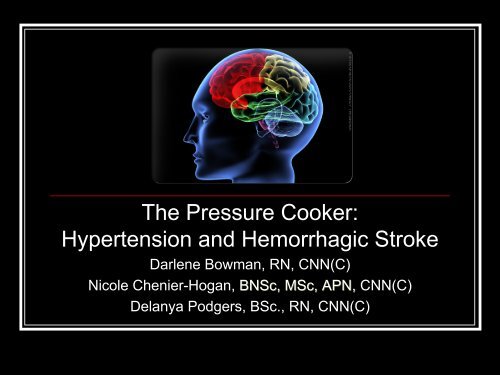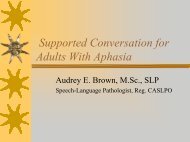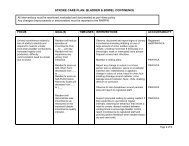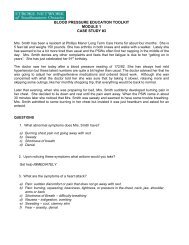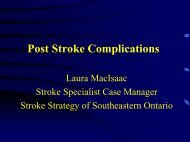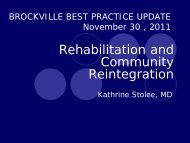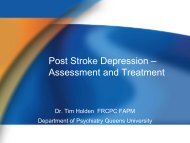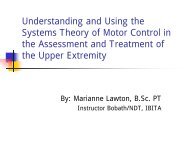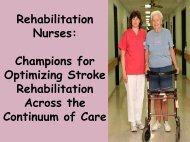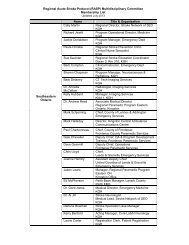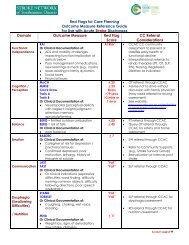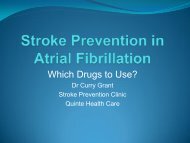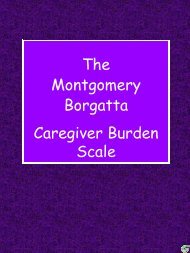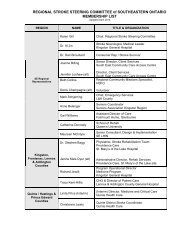The Pressure Cooker: Hypertension and Hemorrhagic Stroke
The Pressure Cooker: Hypertension and Hemorrhagic Stroke
The Pressure Cooker: Hypertension and Hemorrhagic Stroke
Create successful ePaper yourself
Turn your PDF publications into a flip-book with our unique Google optimized e-Paper software.
<strong>The</strong> <strong>Pressure</strong> <strong>Cooker</strong>:<br />
<strong>Hypertension</strong> <strong>and</strong> <strong>Hemorrhagic</strong> <strong>Stroke</strong><br />
Darlene Bowman, RN, CNN(C)<br />
Nicole Chenier-Hogan, BNSc, MSc, APN,<br />
CNN(C)<br />
Delanya Podgers, BSc., RN, CNN(C)
Objectives<br />
�<br />
�<br />
�<br />
�<br />
Review prevalence <strong>and</strong> pathophysiology of<br />
hypertension <strong>and</strong> hemorrhagic stroke<br />
Discuss the relationship between<br />
hypertension <strong>and</strong> hemorrhagic stroke<br />
Review diagnosis of hypertension<br />
Review prevention, diagnosis,<br />
management, rehabilitation <strong>and</strong> outcomes<br />
of hypertensive hemorrhagic stroke through<br />
a case study
Intracerebral Hemorrhage<br />
�<br />
�<br />
�<br />
Approximately 15% of all strokes are due to<br />
intracerebral hemorrhage (ICH)<br />
Incidence<br />
� 15-19 / 100 000 among the general<br />
population<br />
� 200 / 100 000 among the elderly<br />
More common in men than women
�<br />
�<br />
�<br />
Primary hemorrhage<br />
�<br />
�<br />
Spontaneous without obvious underlying cause<br />
<strong>Hypertension</strong> <strong>and</strong> amyloid angiopathy account for 78-<br />
88% of primary hemorrhages<br />
Secondary hemorrhage<br />
� Results from underlying disease<br />
ICH are typically found in the basal ganglia,<br />
thalamus, subcortical white matter, cerebellum<br />
<strong>and</strong> pons
Most Common Sites <strong>and</strong> Sources of Intracerebral Hemorrhage<br />
Qureshi A et al. N Engl J Med 2001;344:1450-1460
Prognosis: ICH Score<br />
Points<br />
GCS 3-4 2<br />
5-12 1<br />
13-15 0<br />
ICH volume (cm 3 ) >30 1<br />
<<br />
30 0<br />
IVH Yes 1<br />
No 0<br />
Infratentorial Yes 1<br />
No 0<br />
Age > 80 years Yes 1<br />
No 0<br />
Total Score 30 day<br />
Mortality<br />
ICH Volume<br />
ABC / 2 rule<br />
0 0%<br />
1 13%<br />
2 26%<br />
3 72%<br />
4 97%<br />
5 100%
�<br />
ICH is dynamic<br />
�<br />
�<br />
Hematoma growth occurs in the first few<br />
hours <strong>and</strong> is associated with neurological<br />
deterioration<br />
Perihematoma edema develops over 3-96<br />
hours <strong>and</strong> contributes significantly to<br />
morbidity <strong>and</strong> mortality
�<br />
�<br />
�<br />
<strong>Hypertension</strong><br />
<strong>Hypertension</strong> is an important risk factor for<br />
stroke <strong>and</strong> cardiovascular disease<br />
�<br />
62% of all stroke events are due to suboptimal BP<br />
¼ of Canadian adults have hypertension<br />
<strong>and</strong> it is estimated that 90% will develop<br />
hypertension over their lifetime<br />
<strong>Hypertension</strong> rates are rising at a faster rate<br />
than predicted
<strong>Hypertension</strong> <strong>and</strong> the Vessel<br />
�<br />
�<br />
�<br />
�<br />
High intralumen pressures alter the endothelium<br />
<strong>and</strong> smooth muscle in intracerebral arteries<br />
Degenerative changes in the smooth muscle<br />
predisposes for ICH<br />
Endothelial damage can lead to thrombi formation<br />
<strong>and</strong> ischemic lesions<br />
Increased endothelial stress can increase the<br />
permeability of the blood brain barrier
<strong>Hypertension</strong> Diagnosis<br />
�<br />
�<br />
SBP >140 mmHg <strong>and</strong>/or DBP >90 mmHg<br />
requires a specific visit for assessment of<br />
hypertension<br />
At the initial visit<br />
�<br />
�<br />
At least three readings should be taken – the first reading<br />
discarded <strong>and</strong> the latter two averaged<br />
History <strong>and</strong> physical should be performed <strong>and</strong> diagnostic<br />
testing to determine end organ damage as indicated<br />
(CHEP, 2010)
�<br />
During the second visit<br />
�<br />
�<br />
Patients with macrovascular organ damage,<br />
diabetes or chronic kidney disease can be<br />
diagnosed with hypertension if SBP remains<br />
>140 mmHg <strong>and</strong>/or DBP remains >90 mmHg<br />
Other patients can be diagnosed with<br />
hypertension if SBP >180 mmHg <strong>and</strong>/or DBP<br />
>110 mmHg<br />
(CHEP, 2010)
�<br />
<strong>The</strong> remaining patients should have further<br />
evaluation<br />
�<br />
Office manual BP – the patient can diagnosed as<br />
hypertensive if SBP >160mmHg or the DBP<br />
>100mmHg averaged across the three visits OR<br />
if the SBP averages >140 mmHg or the DBP<br />
averages >90 mmHg over five vists<br />
(CHEP, 2010)
�<br />
�<br />
Ambulatory BP monitoring – hypertension can be<br />
diagnosed if the mean wake SBP >135 mmHg or<br />
the DBP >85 mmHg OR if the mean 24 hour<br />
SBP >130 mmHg or the DBP >80mmHg<br />
Home BP measurement – hypertension can be<br />
diagnosed if the average SBP >135 mmHg or<br />
DBP >85 mmHg<br />
(CHEP, 2010)
Follow up<br />
�<br />
�<br />
�<br />
If at the last visit the patient was not diagnosed as<br />
hypertensive they should be reassessed yearly<br />
If lifestyle modification alone was recommended<br />
follow should be at 3 to 6 month intervals<br />
Patients on antihypertensive drug treatment<br />
should be seen every 1 to 2 months until readings<br />
on two consecutive visits are below target then<br />
should be seen at 3 to 6 months intervals<br />
(CHEP, 2010)
Lifestyle Modification<br />
�<br />
�<br />
�<br />
�<br />
�<br />
Exercise<br />
Weight reduction<br />
Alcohol consumption<br />
Dietary recommendations<br />
�<br />
Sodium<br />
Stress management<br />
(CHEP, 2010)
Prevention - <strong>Hypertension</strong><br />
�<br />
�<br />
�<br />
Prevention <strong>and</strong> treatment of hypertension<br />
are key<br />
Hypertensive changes in intracerebral<br />
vasculature can be modified significantly by<br />
lifestyle changes such as diet <strong>and</strong> exercise<br />
Education surrounding BP monitoring,<br />
antihypertensive medication adherence <strong>and</strong><br />
lifestyle are essential
Case Study
Mr. W.<br />
ID<br />
� 55 year old male, smoker, lives with spouse <strong>and</strong> 2<br />
daughters, works as a custodian<br />
HPI<br />
� developed severe headache in am<br />
� became drowsy, confused <strong>and</strong> developed an unsteady<br />
gait when walking<br />
� Presented to ER with ↓ LOA but rousable to speech <strong>and</strong><br />
�<br />
continuing to complain of severe headache<br />
Mr. W.’s spouse reports he had not been taking any of<br />
his antihypertensive medications for more than a month
Past Medical History<br />
� <strong>Hypertension</strong> diagnosed in 2005<br />
� Hypertensive crisis treated in fall 2008<br />
� Psoariasis<br />
Medications<br />
� Norvasc 15 mg po daily<br />
� Metoprolol 100 mg po bid<br />
� Ramipril 10 mg po daily<br />
� HCTZ 25 mg po daily<br />
� Terazosin 2 mg po qhs
Physical Exam<br />
� Neurodrowsy, but arousable, GCS 13/15 oriented<br />
to person, PEARL, pupils 2mm bilaterally, moving<br />
all four limbs with 5/5 strength bilaterally<br />
� BP on admission 236/138<br />
� Current BP 191/116<br />
� S1 S2 heart sounds present no audible murmurs<br />
� Chest sounds clear
Investigations<br />
� CT head showed ICH with blood in right<br />
thalamus, extending into ventricular system<br />
into both lateral ventricles <strong>and</strong> into third<br />
ventricle<br />
� Early changes suspicious for mild<br />
hydrocephalus<br />
�<br />
Labs<br />
�<br />
Lytes N, creatinine 119, Hgb 158, leukocytes,<br />
platelets normal
Clinical Management<br />
�<br />
�<br />
�<br />
�<br />
<strong>Stroke</strong> unit care<br />
Imaging to determine hemorrhage<br />
extension, development of hydrocephalus<br />
Medical management<br />
Surgical management
�<br />
�<br />
�<br />
�<br />
Mr. W was admitted to an intensive care for<br />
close monitoring of neuro status<br />
Labetalol infusion was initiated in ER to<br />
decrease BP (goal SBP < 150 mmHg)<br />
NPO for potential OR if condition deteriorated<br />
<strong>and</strong> evidence of hydrocephalus<br />
Investigative workup for secondary cause of<br />
ICH
Course in hospital<br />
� Blood pressure remained controlled with<br />
labetalol <strong>and</strong> oral antihypertensives<br />
� HCTZ 25mg, metoprolol 150 mg bid, ramipril<br />
mg, norvasc 10 mg big, terazosin 5mh qHS<br />
� Neurologically remained stable, no surgical<br />
intervention<br />
15
PT initial assessment<br />
�<br />
�<br />
�<br />
�<br />
�<br />
�<br />
Cognition/communication<br />
MSK<br />
Sensation<br />
Coordination<br />
Balance<br />
Mobility
Assessment findings<br />
�<br />
�<br />
�<br />
�<br />
participation limited<br />
↓balance<br />
↓mobility<br />
↓functional independence<br />
Plan<br />
�<br />
Follow <strong>and</strong> progress mobility
OT initial assessment<br />
�<br />
�<br />
�<br />
�<br />
�<br />
�<br />
�<br />
�<br />
�<br />
�<br />
�<br />
�<br />
Home environment<br />
Social support<br />
BADL<br />
IADL<br />
Productivity<br />
Communication<br />
Object recognition<br />
Cognition - MOCA<br />
Praxis<br />
Visual Confrontation<br />
Strength/Coordination/Sensation<br />
Mobility
OT Recommendations<br />
�<br />
�<br />
�<br />
↓cognitive function<br />
MOCA 22/30<br />
Deficits in visuospatial/executive, language<br />
<strong>and</strong> attention
Social Work<br />
Issues<br />
�<br />
�<br />
Regarding payment for medication<br />
Short term sick leave
<strong>Stroke</strong> Rehabilitation<br />
�<br />
“<strong>Stroke</strong> rehabilitation is a progressive,<br />
dynamic, goal orientated process aimed at<br />
enabling a person with an impairment to<br />
reach their optimal physical, cognitive,<br />
emotional, communicative <strong>and</strong>/or social<br />
functional level”<br />
(Heart <strong>and</strong> <strong>Stroke</strong> Foundation of Ontario)
On Admission to Rehabilitation<br />
�<br />
�<br />
�<br />
Easily distracted by surroundings<br />
Severe difficulties with memory<br />
�<br />
Verbal <strong>and</strong> visual information<br />
Easily fatigued, both physically <strong>and</strong><br />
cognitively<br />
�<br />
When tired easily irritated, frustrated <strong>and</strong> angry
Strategies Recommended- Attention<br />
�<br />
�<br />
�<br />
�<br />
�<br />
�<br />
Focus on one thing at a time<br />
Don’t rush<br />
Work in a quiet environment<br />
Avoid interruptions<br />
Socialize in small groups for shorter visits<br />
Take frequent breaks
Strategies Recommended-Fatigue<br />
�<br />
�<br />
�<br />
�<br />
�<br />
Maintain regular <strong>and</strong> structured routine<br />
Pace yourself<br />
Alternate physical <strong>and</strong> mental activities<br />
throughout the day<br />
Eat a well balanced diet <strong>and</strong> exercise<br />
Take scheduled rest breaks<br />
�<br />
Rest before you are tired
Strategies Recommended-Memory<br />
�<br />
�<br />
�<br />
�<br />
Maintain a predictable routine<br />
Keep an organized environment<br />
Keep important items in the same location<br />
all the time<br />
Use a dosette to organize medications
Mobility<br />
�<br />
�<br />
Altered ambulation-required 4 wheeled walker<br />
� Able to walk short distances with straight<br />
cane<br />
Reduced balance. Berg Balance Scale (BBS)<br />
50/56
Berg Balance Scale (BBS)<br />
�<br />
�<br />
�<br />
<strong>The</strong> BBS measures balance in older adults <strong>and</strong><br />
stroke survivors<br />
In this 14-item scale, patients must maintain<br />
positions <strong>and</strong> complete moving tasks of varying<br />
difficulty. In most items, patients must maintain<br />
a given position for a specified time.<br />
41-56 on the BBS represents good balance.<br />
(<strong>Stroke</strong> Engine,2010)
Strategies Implemented:<br />
Balance & Stability<br />
�<br />
�<br />
Strengthen <strong>and</strong> improve motor control in<br />
proximal muscle groups with activities that<br />
facilitate hip extension with knee flexion, such<br />
as bridging exercises<br />
Improve knee control to avoid or limit<br />
hyperextension during gait with activities such<br />
as st<strong>and</strong>ing small squats.<br />
(Ketsner, 2002)
Strategies Implemented-Mobility<br />
�<br />
Treatment concentrated on gait retraining<br />
<strong>and</strong> endurance training<br />
�<br />
�<br />
Walking-progressed to greater distances on<br />
discharge<br />
Remembered to use cane in left h<strong>and</strong>-on<br />
admission gait better if cane in left h<strong>and</strong>eventually<br />
no longer required cane
Gait Retraining & Endurance<br />
Training<br />
�<br />
�<br />
Practice walking-using cane on various<br />
surfaces such as carpet, gravel, grass <strong>and</strong><br />
concrete<br />
Endurance training-using stationary bike,<br />
focusing on increasing time <strong>and</strong> resistance
Patient <strong>and</strong> Family Concerns<br />
�<br />
�<br />
Participated in adjustment counseling in<br />
hospital<br />
It was recommended that Mr. W <strong>and</strong> family<br />
continue to participate in counseling after<br />
discharge to:<br />
�<br />
�<br />
�<br />
Reduce stress<br />
Ease transition home<br />
Help deal with conflict
Community Reintegration<br />
�<br />
Referral to Regional Community Brain<br />
Injury Services (RCBIS)<br />
�<br />
�<br />
Counselors who assist with transition from<br />
hospital to home<br />
Services include psychology, life skills <strong>and</strong><br />
independence training <strong>and</strong> family support<br />
� Advocacy, social <strong>and</strong> recreational activities,<br />
education <strong>and</strong> information about brain injury
�<br />
Multiple visits to emergency room in months<br />
post discharge:<br />
�<br />
Assessed by clinical psychiatry <strong>and</strong> social work<br />
� Cognitive impairment secondary to stroke<br />
� Demonstrated affective disregulation<br />
� Severe fatigue<br />
� Anxiety<br />
� Periods of lightheadedness<br />
� 60 pound weight loss
�<br />
Most recent ER visit:<br />
�<br />
�<br />
�<br />
�<br />
�<br />
Hypertensive with BP 170/100<br />
�<br />
Given metoprolol<br />
to lower BP<br />
Slurred speech <strong>and</strong> right leg weakness<br />
CT head revealed no acute stroke<br />
Pt revealed that he had not been taking medication<br />
Referred to stroke prevention clinic for follow-up<br />
�<br />
Has not attended appointment
In Conclusion<br />
�<br />
�<br />
Prevention <strong>and</strong> management of<br />
hypertension is key to modifying stroke risk<br />
Interprofessional <strong>Stroke</strong> Care throughout<br />
the continuum is critical for optimal<br />
management
Thank you<br />
Questions
References<br />
Heart <strong>and</strong> <strong>Stroke</strong> Foundation of Ontario. (2010). Retrieved May 15,<br />
2010 from http://www.heart<strong>and</strong>stroke.on.ca/site<br />
/c.pvI3IeNWJwE/b.5339623/k.AD4E/HCP__<strong>Hypertension</strong>.htm<br />
Fric-Shamji, E., Shamji, M., Cole, J. & Benoit, B. (2008). Modifiable<br />
risk factors for intracerebral hemorrhage. Canadian Family<br />
Physicians, 54: 1138-1139.<br />
Lai, S., Chen, T., Lee, T., Ro, L. & Hsu, S. (2005). Spontaneous<br />
intracerebral hemorrhage in young adults. European Journal of<br />
Neurology, 12: 310-316.<br />
Leenen, F., Dumais, J., McInnis, N., Turton, P., Stratychuk, L. et al.<br />
(2008). Results of the Ontario Survey on the prevalence <strong>and</strong> control<br />
of hypertension. Canadian Medical Association Journal, 178(11),<br />
1441- 1449.
Mitchell, P., Dipayan, M., Gregson, B. & Mendelow, A. (2007).<br />
Prevention of intracerebral haemorrhage. Current Drug Targets, 8:<br />
832-838.<br />
Passero, S., Ulivelli, M., Reale, F. (2002). Primary intraventricular<br />
haemorrhage in adults. Acta Neurlogica Sc<strong>and</strong>inavia, 105: 115-<br />
119.<br />
Passero, S., Ulivelli, M. & Rossi, S. (2003). Blood pressure rise in<br />
spontaneous intracerebral haemorrhage: Epiphenomenon or<br />
precipitating factor . Journal of Human <strong>Hypertension</strong>, 17: 77-79.<br />
Rasool, A., Rahman, A., Choudhury, S. & Singh, R. (2004). Blood<br />
pressure in acute intracerebral haemorrhage. Journal of Human<br />
<strong>Hypertension</strong>, 18: 187-192.
Ruhl<strong>and</strong>, J.& van Kan, P. (2003). Medial Pontine <strong>Hemorrhagic</strong> <strong>Stroke</strong>.<br />
Physical <strong>The</strong>rapy, 83(6), 552-566.<br />
Sessa, M. (2008). Intracerebral hemorrhage <strong>and</strong> hypertension.<br />
Neurological Science, (29): S258-S259.<br />
Subramaniam, S. & Hill, M. (2006). Intracerebral Hemorrhage. Calgary<br />
Faculty of Medicine <strong>Stroke</strong> Rounds, 1(1). Retrieved May 15, 2010 from<br />
http://strokerounds.ca/crus/strokeng_11_1206.pdf<br />
<strong>Stroke</strong> Engine, (2010). Retrieved November 19, 2010 from<br />
http://www.medicine.mcgill.ca/strokengine-assess/module_bbs_indepthen.html
Thrift, A., McNeil, J., Forbes, A. & Donnan, G. (1998). Three important<br />
subgroups of hypertensive persons at greater risk of intracerebral<br />
hemorrhage. American Heart Association, 31: 1223-1229.<br />
Tu, K., Chen, Z. & Lipscombe, L. (2008). Prevalence <strong>and</strong> incidence of<br />
hypertension from 1995 to 2005: A population-based study. Canadian<br />
Medical Association Journal, 178(11), 1429-1435.


